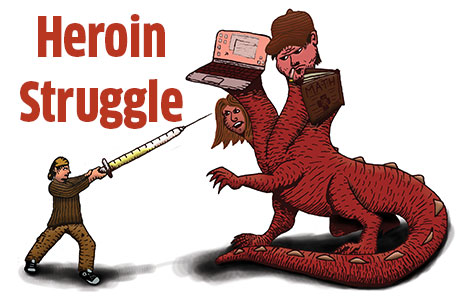Heroin use grows in Dane County
December 10, 2014
To say that heroin use and addiction is a problem in Wisconsin would be a gross understatement. The Wisconsin Department of Justice (DOJ), says that heroin use is rapidly becoming their biggest public safety concern. In 2013, the number of heroin-related deaths in Dane County rose by 30 percent, according to the Wisconsin State Journal. Former Madison College student Kevin LeRette, age 24 was one of these tragic deaths.
On March 11, 2013 LeRette’s best friend and former Madison College student Justin Morse, age 26, injected LeRette with a dose of heroin that, when mixed with the alcohol already in LeRette’s system, ended up being fatal. Morse was recently sentenced to two years in prison and hundreds of hours of community service for the offense.
The DOJ refers to the problem of addiction as a spiral effect in their heroin prevention campaign, The Fly Effect. Dana Brueck, the Communications Officer at the DOJ spoke about the Fly Effect campaign, initiated by Attorney General J.B. Van Hollen in 2013, and explained, “The fly effect is based on an old nursery rhyme that says, ‘There once was an old lady who swallowed a fly,’ and she swallows all these different ever-increasing number of animals to catch the fly, right? So, it’s kind of this idea of a spiral.”
Research shows that there is an unmistakable link between the use of prescription painkillers and eventual heroin use.
“It starts, you know, maybe with swiping percocet or vicodin or oxy from the household medicine cabinet and young people think that might be safe. They start using prescription drugs and then it spirals into this heroin abuse,” Brueck said. She goes on to say that this is probably because heroin is “cheaper and often times more readily available.”
Patrick Kempfer, Peer Coordinator at the Downtown Student Life office and Recovery Community Center Coordinator at WIRCO (Wisconsin Recovery Community Organization) struggled with heroin and other drug addiction for 18 years of his life.
“Young people (are) compelled to tune out, to distract themselves somehow. Because there’s so much fear and panic (and) most people spend the majority of their lives feeling totally, 100 percent uncomfortable. All of that anxiety, all of the fear, heroin just takes it away…Now unfortunately, while not being affected by all the negative things, you’re also not able to participate in any of the positive things. What the heroin addict does is they trade their life for comfortability,” said Kempfer.
Users also lose perspective swiftly; they don’t understand the effect their addiction has on those around them.
“I remember defending myself to people who had tried to get me to stop using, saying ‘Who am I hurting? Myself? Why does anyone care?’…I never thought I would hurt anybody. I never wanted this,” said Morse.
What makes heroin such a risk? Well, when you buy it, you never know what you’re really getting. Street heroin is often times mixed with other substances such as caffeine, sugar, Benadryl, or quinine and it’s impossible to know what effect any given dose will have on you. It’s also fiercely addictive. According to the DOJ, “more than 75% of those who try heroin once will use again.”
And, the brain builds up a tolerance over time, causing the addict to require more and more heroin to achieve the same high.
“It ends up where you spend every waking hour pursuing that high, not even really to be high anymore, just to not feel sick,” Kempfer said. The nasty withdrawal symptoms include bone pain, fever, diarrhea and vomiting. Complications from usage include collapsed veins, infected blood vessels, kidneys and lungs, contraction of AIDS or infections from needles, respiratory illness, breakdown of immune system and all too often, death.
Unfortunately when heroin is involved, it is more often than not the case of too little, too late and the consequences last a lifetime.
A heroin addict is far from helpless though, and Kempfer wants people to know that “recovery happens” and that it “needs to be a community effort.” There are dozens of resources in Dane County thanks to the awareness raised in recent years due to the efforts of WIRCO, The Fly Effect campaign, The Recovery Foundation, and other similar programs, and Kempfer is trying to start up a Madison College chapter of the Life Free Student Wellness and Recovery program.
Gov. Scott Walker also signed various bills in 2014 that help give people immunity from prosecution for drug possession if they call 911 or bring someone to the hospital for an overdose, to make naloxone – a substance that helps counteract heroin and other opiate overdoses – more widely available to law enforcement, and add funds to treatment and diversion programs.
Heroin’s popularity is unfortunately continuing to grow due to its availability and relatively low cost. According to the DOJ, the number of Wisconsin teens ages 12-17 who have tried heroin has increased 300 percent since 1995. While recovery is essential to fighting the heroin epidemic, prevention is just as critical. “We want to reach people before they ever think of trying heroin,” Brueck said. “It only takes one time to become addicted, and it only takes once for it to take your life.”
According to the DOJ, somebody dies of a heroin overdose every 44 hours in Wisconsin. Heroin addiction is progressive, and the longer someone is addicted, the harder it becomes to stop.
The last thing Morse said in his statement during his sentencing was this: “A few days before Kevin passed away he wrote ‘Please stop using drugs. Your friend, Kevin.’ on the whiteboard in our apartment. I will always regret not listening to him.”































